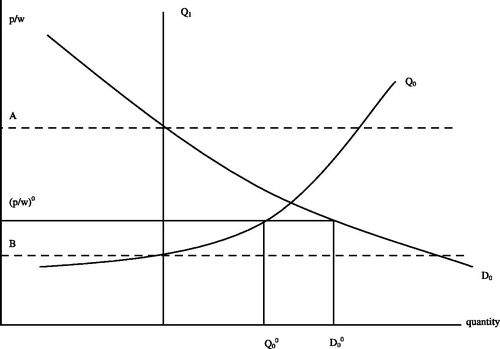Figures & data
Figure 1. The aggregate perfect competitive goods market under repressed inflation. The price level is set to p0. The supply curve consists of the aggregate marginal cost curve m. c. up to the quantity Q1, which is the maximum possible goods production given the available quantity of labour. After that follows a vertical part B1B2. The quantitative excess demand in the commodity market equals D1 - B1, the ex ante commodity gap equals the area B1Q1D0D1 and the inflationary gap in the labour market the area B2Q1D0D1. Excess demand in the aggregate factor market is reflected in how much more goods the firms would like to produce if there was no rationing in the labour market, Q0 - Q1. The inflationary gap in the labour market equals the area B2Q1Q0C1 and unexpected income loss by the firms area B1B2C1. The income loss is equal to the expected profit on production which could not be realised due to shortage of labour.

Figure 2. The aggregate goods market under open inflation. Q1 denotes production given the available labour supply, Q0 planned supply of goods, D0 demand for goods, A the level of p/w where the goods market is in equilibrium, B the level of p/w where the labour market is in equilibrium. (p/w)0 denotes the quasi-equilibrium value of p/w; here price and wage inflation are equal. In quasi equilibrium the excess demand in the goods market is given by D0° – Q1 and the excess demand in the labour market is implicitly given by the distance Q0° – Q1 (to measure excess demand in the labour market the distance measured in goods volume has to be transformed to volume of labour via the inverse of the production function).

